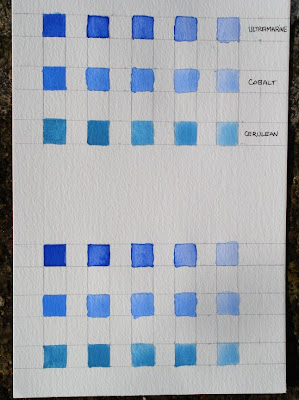A cyanometer, step by step
My previous post, Blue sky research with a cyanometer , I introduced you to the cyanometer and its use for artists. I will now explain how I built mine.
My previous post, Blue sky research with a cyanometer , I introduced you to the cyanometer and its use for artists. I will now explain how I built mine.
- I cut a rectangle of cardboard (15 cm x 10 cm)
- I traced on the cardboard three rows of squares (1.5 cm x 1.5 cm). Each row was separated by 1 cm.
- I cut out the windows in the cardboard
- I painted on a sheet of watercolour paper two identical sets of blue squares using watercolour paint that I diluted more and more with water in order to get graded blue shades. I used some Ultramarine blue, Cobalt blue and Cerulean blue.


- I cut one of the sets and numbered the colours from 1 to 15 (the reason I painted 15 squares rather than 12 is that I anticipated that some shades would be too close to each other to make a real difference. I gave myself the possibility to eliminate 3 of these too similar shades)
- I then ordered the shades from darker to lighter and reported the order onto the reference chart.




- The dimensions of the cyanometer and of each coloured square do not really matters. The idea is that you want your cyanometer to be small enough to be able to pack it in your painting box or bag when you go on your field trips.
- On reflexion, it would be better to have many more shades of blue to have closer matches with the colour of the sky. Around 40 shades would give a better spread and there a higher chance to find the perfect match. I found that Turquoise blue was missing and Blue Rex could prove useful. Additional shades of blue could also be obtained by mixing together some of the blue I used on their own. For instance, you could mix “Ultramarine + Cerulean” and then lighten the new colour with white to generate a new series.
- It is probably easier to grade colours with oil or acrylic paint rather than with watercolour because you can use some white paint to get a nice and regular gradation. I found more difficult to control how much water I had to add to my colour from one square to the next.
Related articles
Blue sky research with a cyanometer ,


No comments:
Post a Comment
I would like to know what you think about my art and my posts. Feel free to ask questions. No advertising links in comments please.